
Honoring the Dead,
Celebrating Life with
Día de Muertos
Making an Ofrenda,
Learning the Traditions
of Day of the Dead
By Ryan P. Cruz
Photos by Ingrid Bostrom
October 24, 2024
For a complete list of this year’s Día de Muertos/ Day of the Dead Events, click here.
For a complete list of this year’s Halloween happenings, click here.
Every year around the end of October, Mexican and Latino American communities build monuments to the dead — altars that overflow with fragrant marigolds, glowing candles, family photos, and offerings of food and drink. These ofrendas, in living rooms, churches, and public places, are a core part of Día de Muertos, the annual celebration to honor and remember the dead.
While my grandmother and mother were both born in Mexico, my family had never really practiced Día de Muertos (also known as Día de los Muertos or Day of the Dead). I was always familiar with traditions, the parades, and the altars, but I had never fully learned about what they meant and where they came from.
So this year, with the deaths of my grandmother Luz and cousin Kaelynn heavy on my heart, I wanted to take the opportunity to reconnect with Día de Muertos on a deeper and more personal level, and to honor those who have passed on to the next life — not just in my family, but for my friends and acquaintances who have died over the years. It was important that I understood what Día de Muertos means, about its history, about each symbolic piece of the ofrenda, and what these traditions mean to the Latino community.
What Is Day of the Dead?
Father Pedro Lopez, pastor of Our Lady of Guadalupe, who hosts a church celebration of Día de Muertos every year, helped explain the history of how the holiday developed.
While Catholicism is firmly entrenched in current Día de Muertos celebrations, its roots go back to ancient Aztec and Nahua peoples, whose beliefs of death and spirituality were far different from the European Christianity that would later arrive.

These indigenous beliefs saw death not as the end of life, but as something that is just another step in the cycle of life. “There’s a closeness to death throughout life,” Father Lopez said. “It’s not something to be afraid of, but it’s part of life.”
When the Spanish arrived, these beliefs were “synchronized” into the Catholic calendar of holidays on All Saints’ Day (Nov. 1) and All Souls’ Day (Nov. 2): feasts that honor the saints and all the souls who are in heaven, Father Lopez said. The ancient practices mingled with the new.
But the core of the indigenous belief remained the same: During that brief period, the spirits of the dead would be able to return from the other world, Mictlán, to visit the living and celebrate.
Over the centuries, different traditions and rituals developed in the various regions of Mexico, adding their own unique flavor — with some people building ofrenda altars in their homes to welcome the spirits, while others visit the cemeteries to remember and include the spirits of their ancestors in family gatherings, dancing, and food.
Here in the United States, Day of the Dead is often wrongly thought to be the Mexican Halloween. But the European traditions of Halloween on October 31, the eve of All Saints’ Day, is more about being afraid of the spirits of the dead — of being spooked or scared. On Halloween, costumes originated as a way to ward off spirits. This is the opposite of what Día de Muertos celebrates — it is a welcoming and embracing of those who have died, with people wearing the skeleton Catrina costume as a way to celebrate and pay homage to the visiting spirits.
This alternative view of death, as something not to be dreaded but embraced, can help “reframe the traditional American view of death as tragic,” said Kendra Saffie, who runs teen programs at the Eastside Library. “Yes, death can be tragic, but it’s more important to celebrate life as we have it now and to celebrate the lives of the people who are no longer with us. That reframing, I think, is really healthy and beautiful.
“Día de los Muertos is definitely a combination of those indigenous cultures before Spain,” Saffie said. “Indigenous people took their traditions, which coincided with the harvest time, then Catholicism mixed with that to create this beautiful new tradition.”
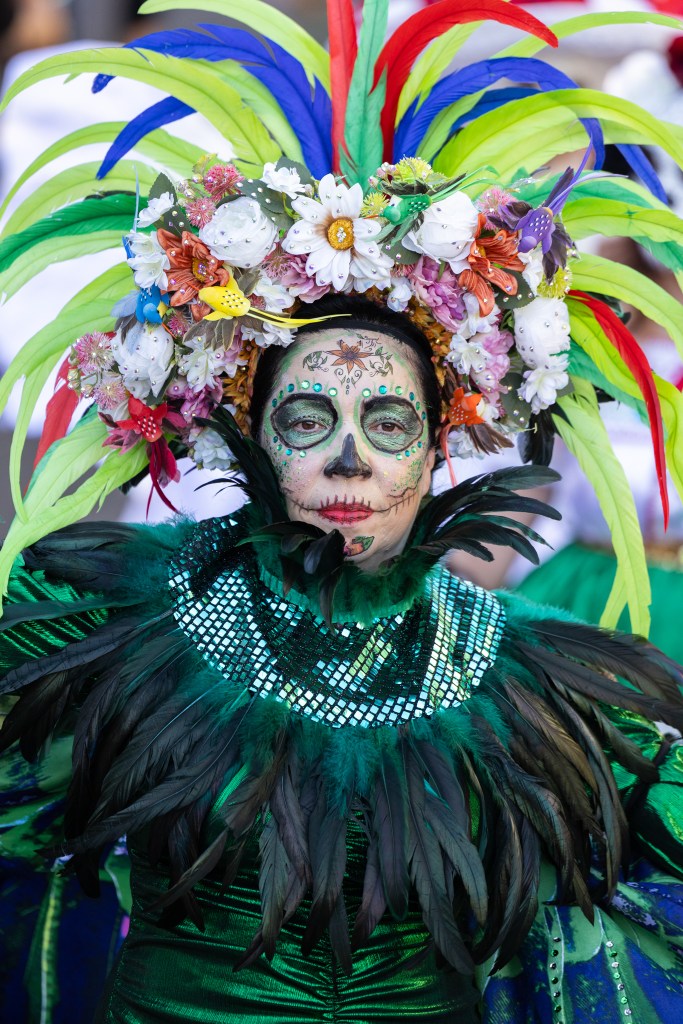
Saffie worked with young people to create a community altar for this year’s events in Santa Barbara. She said that one of the most amazing things about Día de Muertos is the blend of different cultures converging in today’s version of the holiday, with parades, ofrendas, sugar skulls, Catrina skeleton costumes, and special offerings of pan de muerto.
“I think it’s really important that our community, especially young people, know where these traditions come from,” Saffie said. Most importantly, she said, the current celebrations of Día de Muertos keep these ancient traditions alive by passing them down to the next generation.
Today’s Día de Muertos celebrations are more diverse than ever, with Mexican and Latino Americans bringing the holiday with them wherever they go and welcoming their new neighbors to celebrate. Now, Día de Muertos celebrations in America are embracing the imagery and traditions of the ancient holiday, while welcoming people of all cultures to join in the festivities.
“It’s all about community and bringing people together,” Saffie said. “And I think the more we can acknowledge our similarities and celebrate those things, while also honoring our past and thinking back to our ancestors — especially for so many folks who have ancestors who immigrated here — it’s so important to honor that journey and all of the sacrifices that our families have made for us to be here.”
Working on an Ofrenda
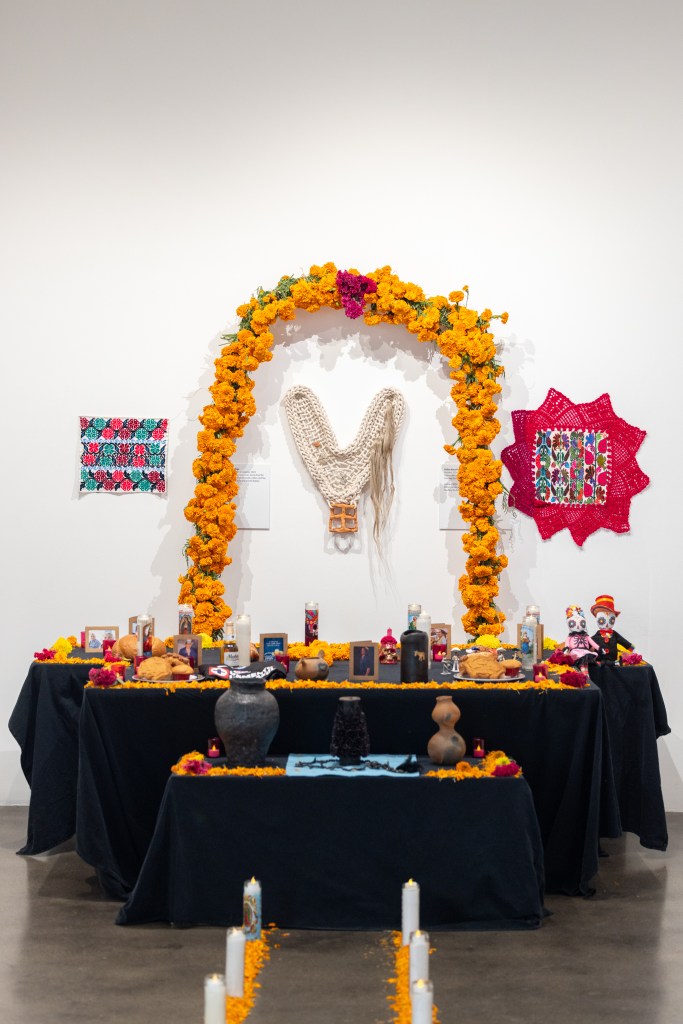
To learn about creating an ofrenda for my family, I talked to artist, cultural worker, and UCSB graduate student John Jairo Valencia, who has practiced Día de Muertos with his family for more than 20 years. Valencia now hosts workshops of his own where he teaches students and community members how to cut the delicate papel picado and create an altar to connect with their ancestors.
Valencia stressed the importance of getting to know your family, your ancestry, and where you came from as part of the process of building your altar. That could mean finding objects that are meaningful to your family’s story, or learning the history of your spiritual practices.
For my ofrenda, I worked with family members to get pieces that were important to my grandma and my cousin. I cleared a bookshelf space in my living room, and laid several of my Grandma Luz’s manteles (decorative tablecloths embroidered with pink roses), along with one of her favorite silk scarfs. For my cousin Kaelynn, I displayed a fountain pen she had bought me as a gift when I first was hired as a full-time journalist. For both, I placed family photos and the gloves I had worn as a pallbearer at their funerals.
For those that celebrate Día de Muertos, Valencia says, the process of creating the altar itself — and bringing personal connections into the ritual — can be an act of healing and grieving.
“I felt like the tradition of Día de los Muertos helped me think about my connection with my ancestors,” Valencia said. “That act of making, of preparing for the ofrenda, is the work you need to do. It’s not just the celebration; it’s the homework beforehand that creates this connection with our ancestors.”
During these workshops, Valencia encourages people to make their ofrenda their own, to learn what makes their family unique, and to share their stories.
“That’s the most beautiful part of this tradition,” Valencia said. “It’s about bringing people together to tell stories. About creating identity and belonging.”
Welcoming the Spirits
While Valencia said that creating an ofrenda can help people understand their connection with their past, and while there were many ways of making an altar your own — such as including “spiritual ancestors” (for me, I included my journalistic heroes Ruben Salazar and Anthony Bourdain) — there are certain elements that are traditionally included in every Día de Muertos celebration.
Each ofrenda has similar pieces, including at least one item representing all four elements, with each serving a specific purpose. Brightly colored papel picado represents air; cups of water help open communication and quench the spirits’ thirst; fire is represented by candles, to lead the spirits to the ofrenda; and earth is represented by foods and salts.
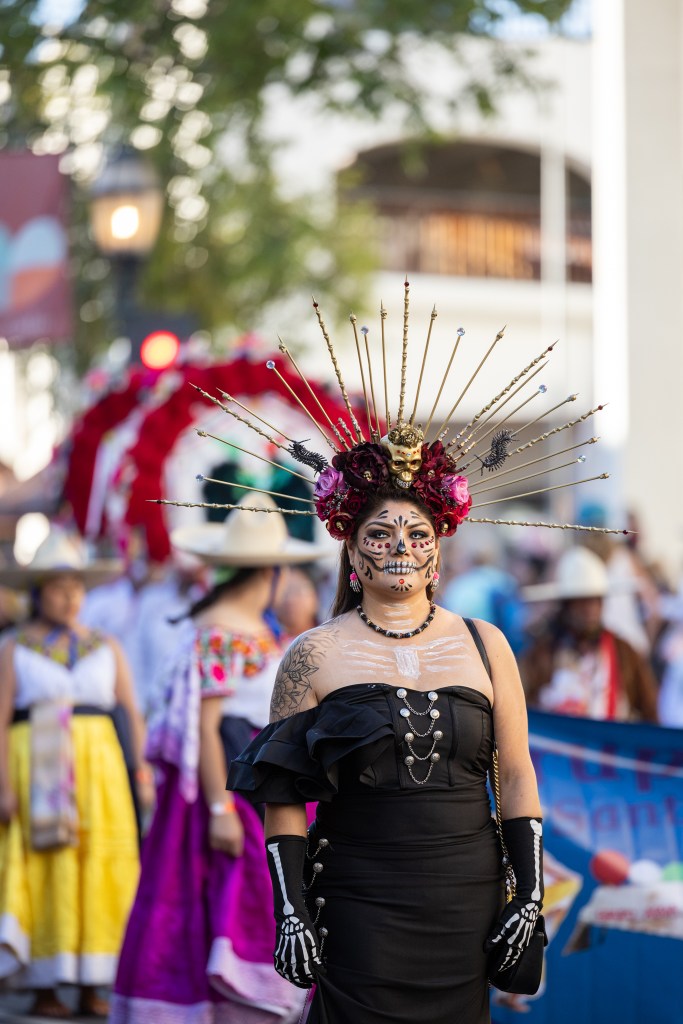
Other common symbols include butterflies, representing rebirth; offerings of white bread and fruits; and marigolds, known as the cempasúchil, or “flower of the dead,” which help guide the spirits with their bright color and fragrant smell. All of these serve a spiritual purpose to help lead the souls back to their families on Día de Muertos.
The most common Día de Muertos celebrations, including those hosted by Catholic churches, are spread over two days — typically November 1 and November 2 — which coincide with parades and church ceremonies on All Saints’ Day and All Souls’ Day.
But many families celebrate for much longer, building their altars to the dead weeks earlier. Some choose to celebrate for more than a week, welcoming the souls as early as October 27, when the souls of pets who have passed are said to arrive as the first otherworldly visitors.
On October 28, the first candle is lit and a white flower is put on the altar for the lost souls. The next day, another candle is lit and a glass of water is left out for spirits who are forgotten or helpless. October 30, a third candle and a piece of white bread, or pan de muerto, is placed on the altar to feed those who died without a final meal.
On October 31, another candle, a third glass of water, bread, and fruit are left for ancestors — including grandparents, great-grandparents, and other relatives.
On All Saints’ Day, November 1, food is set out for those who died as children. On All Souls’ Day, November 2, the rest of the deceased come to visit and eat all the offerings placed on the ofrenda. Copal or incense is typically burned to help guide the souls back home.
And on the final day, November 3, a final white candle is lit, along with incense, and we say one final goodbye to the spirits before asking them to return next year.
The Coco Effect
Disney’s 2017 film Coco brought Día de Muertos to the masses, and while it has done wonders for educating the public about the traditions of Día de Muertos, it has also done its part in commodifying the holiday, to the point of Disney literally attempting to trademark the phrase “Day of the Dead” itself.
This commercialization of a sacred holiday was seen as an affront to many who celebrate Día de Muertos as a deeply personal and spiritual occasion.
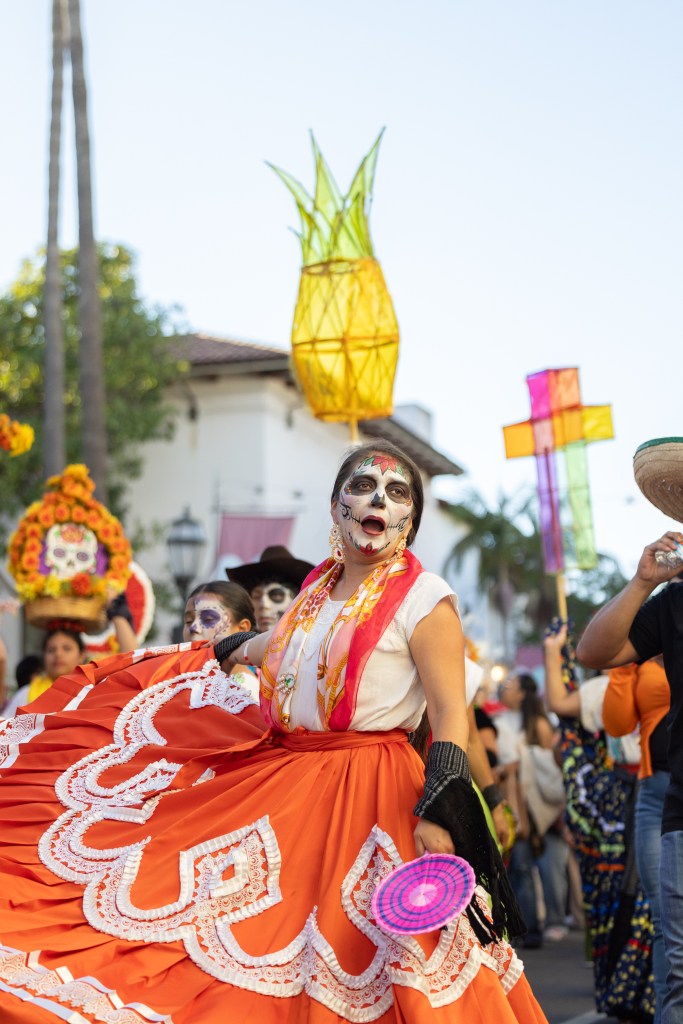
“The responsibility of keeping the celebrations organic, authentic, and connected to this intended meaning is important for cultural preservation,” said Andi Garcia, a community advocate and one of the organizers behind the series of Día de Muertos events at Ortega Park. “Commercialization of this heritage-rooted tradition, such as the copyright attempt by Disney, reminds us we are in a capitalistic society and have little control over our tradition being appropriated.”
But in other ways, the movie taught the greater public the basics of Día de Muertos, and introduced the traditions of ofrendas to a new generation of Latinos who had been cut off from the holiday.
During the community altar building workshop, Maria Botello, a library technician at the Eastside Library, talked about the positive effect that Coco brought to the culture.
“I think that was a special movie,” Botello said. “Because we sometimes leave the tradition over there [in Mexico], so it was kind of going away. And with this movie, it just really revived everything, and now the little ones know what the ofrenda is.”
She said that it is important to teach the youth about the traditions of Día de Muertos, and to have a special time every year to think about those that have died.
“We remember them every single day,” Botello said. “But having a special day to celebrate is good and teaching the children is very important, because that’s how the traditions are going to be passed down.
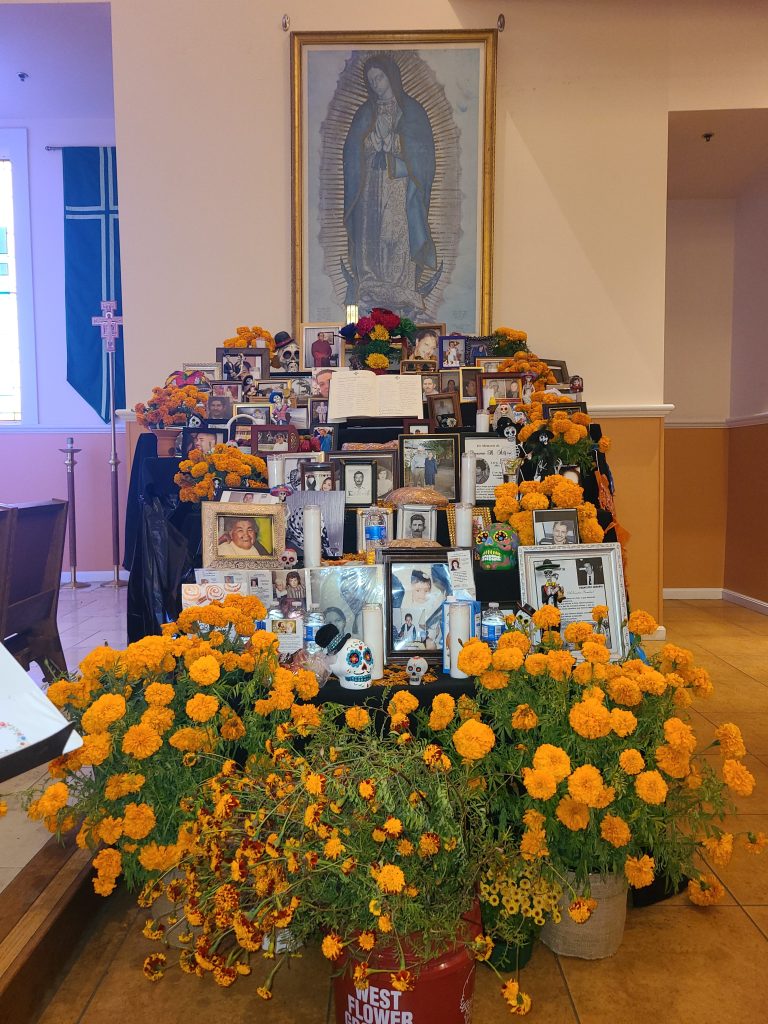
Ofrendas in Santa Barbara
Several community altars will be on display throughout Santa Barbara during the next few weeks, built by groups keeping Día de Muertos alive on the Central Coast.
At Ortega Park, Garcia and a group of dedicated volunteers organized a series of events, including a sugar skull workshop and a community altar that will be up on November 2 and 3. The theme of this year’s event is Un Recuerdo Alegre: Día de los Muertos (“A Happy Memory: Day of the Dead”).
“Community altars essentially serve to celebrate our deceased loved ones’ presence and impact on our lives reconnecting with those joyful memories,” Garcia said. “Providing opportunities to celebrate with vibrant colors, the building of altars, and a gathering ofrendas such as favorite foods and photos creates an alleviation to brighter days for those in the throes of mourning…. I get to honor those who have inspired me, lifted me, and made a lasting impression.”
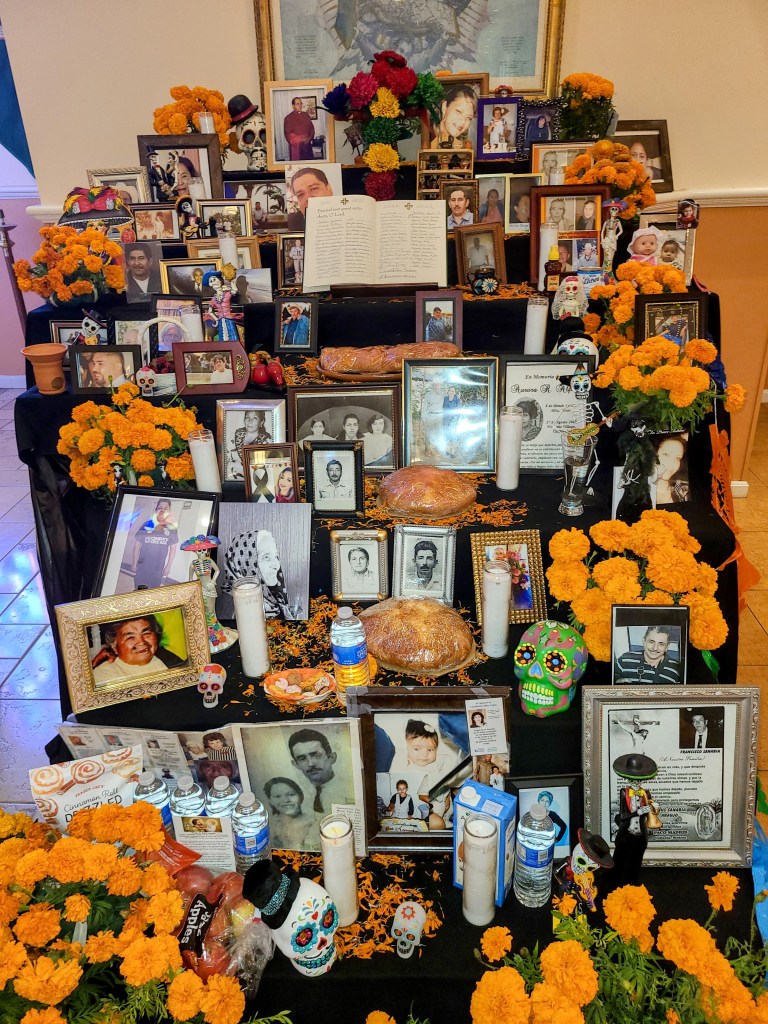
Just a few blocks away at Adelante Charter School — a Spanish-English two-way immersion elementary school on the Eastside where kids from all backgrounds learn together — the students and parents of the 6th-grade class put together a community ofrenda to celebrate the 21st annual Day of the Dead at the school. This year’s Día de Muertos Festival at Adelante will feature Latin American artists, games, food, music, and dancing.
Over at Our Lady of Guadalupe, the community altar will be on display inside the church through the whole month of November, with churchgoers adding their own family photos and keepsakes over the next few weeks.
And on November 3, the Mujeres Makers Market and Santa Barbara Trust for Historic Preservation will have a community altar on display during the Día de los Muertos Market & Craft Day at El Presidio de Santa Bárbara State Historic Park.
Día de los Muertos/ Day of the Dead Events
By Terry Ortega
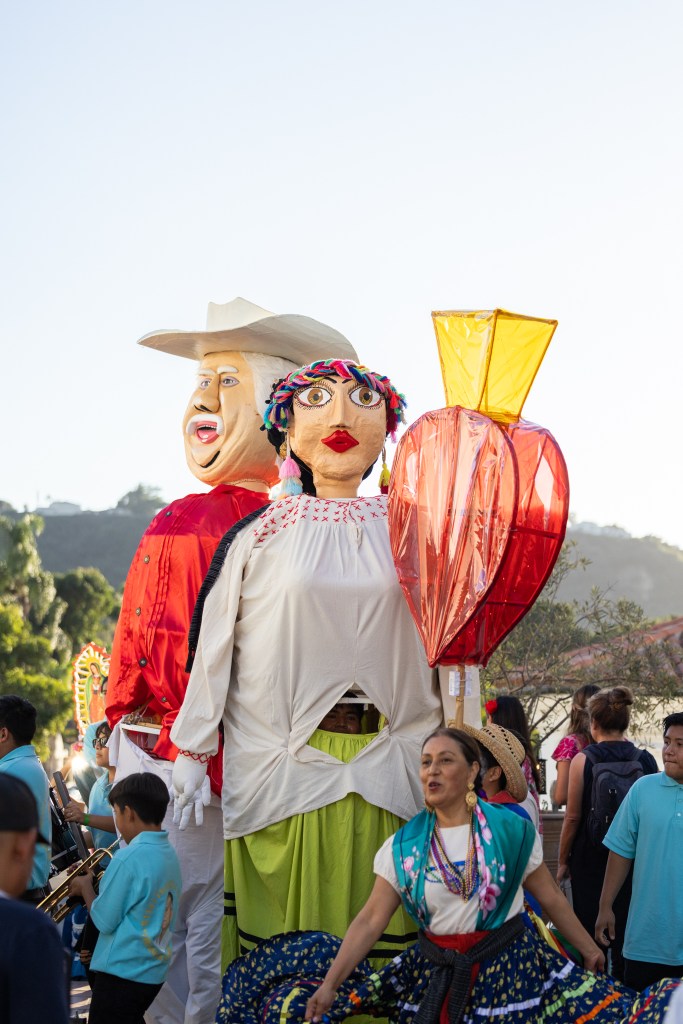
10/25: La Calavera Paint & Sip Artist Martha Torres will lead this skull color and culture paint night as you enjoy light appetizers and drink specials. Proceeds will go toward @ortegaparksb. 6-9pm. Baja Sharkeez, 525 State St. $35 donation. Ages 21+. Text (724) 860-8686. tinyurl.com/CalaveraPaintSip
10/27: Ortega Park Presents Sugar Skulls Workshop Dora Pérez will share the traditions from her hometown of Irapuato, Guanajuato, México, and lead you in this workshop to create sugar skulls. 1-3pm. Ortega Park, 604 E. Ortega St. Free. tinyurl.com/SugarSkullsWorkshop
11/1-11/2: Un Recuerdo Alegre: Día de los Muertos S.B. / A Happy Memory: Day of the Dead S.B. Celebrate the holiday with a two-day event featuring several community workshops leading up to a magical, spiritual, and joyful ceremony. Fri.: 4pm, Sat.: 7pm. Ortega Park, 632 E. Ortega St. tinyurl.com/DiaDeLosMuertosSB24
11/2: Lompoc Unified School District Annual Día de los Muertos Celebration: Honoring Our Cultures to Inspire Our Future Families and community members are invited to visit to the altars to honor loved ones who have passed; see student art displays; enter the Catrina contest; enjoy arts and crafts, pan de muerto, and hot chocolate; and visit community booths for resources and information. 2-7pm. El Camino Campus, 320 N. J St., Lompoc. Free. Email diadelosmuertos@lusd.org. tinyurl.com/Lompoc-DDLM
11/2: Chicano Culture de S.B. Annual S.B. Mural Bike Ride Calling all art enthusiasts, cyclists, locals and tourists, families, and anyone looking for a unique way to experience hidden gems and snap some Insta-worthy photos as you cruise from mural to mural. Meet up: 1pm; ride: 1:30-3pm. Ortega Park, 604 E. Ortega St. Free. Email michaelproduce@gmail.com. tinyurl.com/MuralBikeRide2024
11/3: Fourth Annual Mujeres Makers Market and SBTHP Día de los Muertos Market & Craft Day View and pay respects to deceased ancestors by leaving a photo or memento at the community altar; enjoy workshops, face painting, a deejay, dance performances, a Catrina contest, Lotería and a photo booth; and shop from more than 70 vendors featuring women of color, artisans, vintage curators, and more. 10am-4pm. El Presidio de Santa Bárbara State Historic Park, 123 E. Canon Perdido St. Free. Email info@MujeresMakersMarket.com. tinyurl.com/DDLM-MujeresMarket




You must be logged in to post a comment.